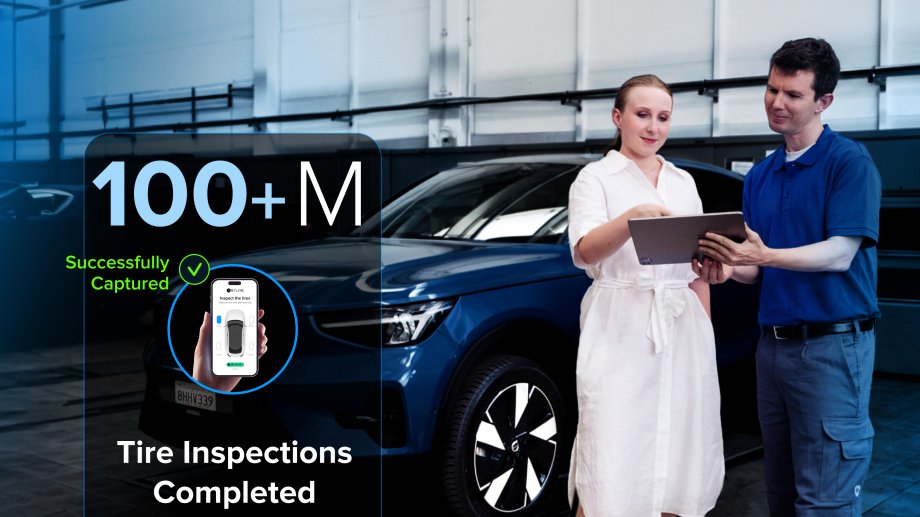
The Fine Art of Tire Data Collection: How to Scan Codes, Sizes and More
If you had to make a list of some of the components of a car that people don’t think too much about, tires would be right at the top. But there’s a lot to learn – all of which can be pretty important.
Case in point: the digits on the sidewall can actually clue you into a lot of important details about the tire itself, including the size, age, weight and speed limits. Problem is, most people don’t understand what these numbers even mean!
But thanks to new scanning technology, it’s easy to have tire data collection at your fingertips, in a matter of milliseconds – so you can make the most informed decisions possible moving forward.
How to read a tire
Firstly, it’s important to know that tire codes can vary based on regions. In North America, for example, tire codes typically begin by indicating the type of tire. In Europe, on the other hand, the type comes near the end.
- The most common letters on a tire sidewall to indicate the type will be the letter “P” at the beginning of the code. This informs us that you’re working with a P-Metric tire intended for passenger vehicles.
- If the tire size doesn’t actually have any letters at the beginning of the code, this could be an indication that it’s a Euro metric tire. This will likely have a different load capacity than a P-Metric tire.
- The letters “LT,” are an indication of the fact that the tires themselves are designed for light trucks.
The width is another important consideration when it comes to what this code means. The tire width is measured in millimeters – and the first three-digit numbers in the tire size are what refer to this tire width.
Next is the aspect ratio, which describes the ratio of the height of the tire’s cross-section to its width. To find out more about the ratio, you would need to take a closer look at the two digit number that usually appears after the slash mark on the tire itself.
The following codes indicated what is the actual construction of the tire. This is shown by the letter that separates the final two sets of numbers, ultimately referring to the fabric that makes up the tire itself. If you see a letter “R”, for example, this is indicative of radial construction. The letter “B” would refer to bias belt construction, and “D” means it has a diagonal belt.
A wheel’s diameter is also a part of this process, and it is measured from one end to the other. It tells us the size of the wheel that the tire itself is intended to fit.
Keeping track of all this information is obviously a bit overwhelming if you’re not a seasoned professional, but it’s important nonetheless. As we have seen, different regions have different standards and if you ever find yourself in a tricky situation, you’ll be glad that you’ve committed all of this to memory.

What are the advantages of tire scanning?
Given the fact that all of this is a lot to keep track of, the advantages of using technology for the purposes of tire scanning is rather obvious. Some of the most important include but are not limited to things like:
- Increased accuracy. When you use a solution like Anyline’s OCR technology, the highest degree accuracy rating is guaranteed. This eliminates the inevitable manual data entry errors that happen when relying on humans to do a robotic task!
- Time-saving. Not only do these newer types of solutions handle the data capturing process easier than ever, but Anyline’s OCR technology can scan 20 times faster than a human ever could on their own.
- Less stress. To say that reading tires is a hassle for technicians is probably a bit of an understatement. By being able to deliver the most accurate data as quickly as possible, they’re able to perform more work during a given day. This in turn leads to people who are more engaged with their jobs, which ultimately leads to a more successful business as well.
- Saving resources. Again, when the reading process is this fast and this efficient (not to mention accurate), those technicians are free to focus more of their time on those tasks that can derive the most value for the business. They’re not forced to contend with time-consuming, menial tasks that take them away from more important matters.
- Location and connection independent. With Anyline’s solution in particular, you don’t have to worry about whether you’re dealing with a bad Internet connection because everything is designed to operate offline.
How does tire scanning simplify automotive tasks?
One of the main ways in which tire scanning simplifies automotive tasks is during inspections. Historically, a technician would need to physically examine the tire DOT and manually write it down to get the data they need to do their work. But by scanning that DOT, everything is available at their fingertips in a matter of seconds. For an example of this tech in action, read about how Discount Tire technicians perform tire inspections in under 5 seconds!
Inventory management is also another major benefit to organizations. For tire retailers, OCR technology allows technicians to effortlessly scan each tire as it arrives – all of which is information that will then be stored in their internal database. But more than that, they’ll know information like when the tire was manufactured, how long it has been sitting in inventory and much, much more.
All of this is important to know for tire retailers, and using tire scanning technology is up to five times faster than having employees collect this data on their own.
Tire hotels gain a further benefit from faster identification for storage of both winter and summer tires. Tire size codes can be captured as additional identification data. If recorded when a tire comes in, DOT data can be verified when customers get their tires back to make sure they’re getting the right ones.
Tire eCommerce is another one of the major ways in which organizations can benefit from this technology. Tire size scanning can be integrated into a wide range of different environments like tire retail websites. This allows customers to scan their existing tires using their own phones, and instantly see what tires they could buy to replace them. This not only makes it easier for customers to buy tires online, but it also removes a lot of the confusion and uncertainty that they have. This saves everybody time and creates a better user experience, which is likely the most important benefit of all.
How Does It Work?
Tire data capture is a form of mobile optical character recognition (OCR), which is developed using advanced AI and machine learning techniques. OCR enables the user to scan vehicle tire numbers in an instant with any camera-enabled mobile device.
By simply integrating the Anyline SDK into an app or website, it’s possible for workforces and customers to capture tire data using any standard smart device. For example, workers anywhere throughout the supply chain can scan a tire DOT code and transfer that information instantly into their system or database, all while making sure that information is both accurate and up-to-date.
Mobile TIN scanning of this type eliminates the need of manual tire data collection, which largely removes the possibility that human error will enter into the equation. It makes things faster, easier and more efficient, which are always the goals that organizations are striving for.
How can Anyline be integrated?
Anyline mobile data capture can be integrated directly into any tire shop company’s existing system. Employees can therefore use our mobile apps on their current TPMS devices, or even their own smartphones!. And by integrating Anyline’s OCR technology, tire shop owners can not only go a long way towards reducing ownership costs – they can also create a solution that is as easy as possible for their workers at the exact same time.
Anyline’s SDK was designed to be easy to integrate with any mobile app or website that you might already be working with. Indeed, this can be done with just a few quick lines of code. Once that happens, you can start optimizing your data collection processes within a matter of minutes – all by way of industry leading technology. You don’t have to worry about wasting time via manual data entry. You don’t have to concern yourself with the dreaded human error. You can sit back and rest easy knowing that everything is finally being taken care of.
Anyline’s SDK works with Apple iOS and Android. It also comes with a high level of support, offering compatibility with many common integration frameworks including Xamarin, React Native, Cordova and Flutter.
So if you’d like to find out more information about why tire data collection matters so much, or if you just have any additional questions that you’d like to discuss in a bit more detail, please don’t delay – contact us today. You can also download the mobile data capture demo app to test the Anyline SDK‘s capabilities for yourself.



